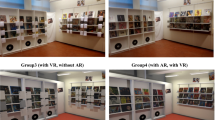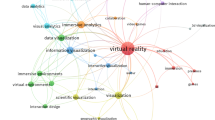Abstract
Alternative reality (XR) tools are becoming more commonplace in the realm of architecture, engineering, and construction (AEC); however, these digitally immersive technologies vary greatly in their degree of virtuality and individual capabilities. While many studies detail the performance of one specific XR technology for a particular use case, little work exists comparing numerous modern XR technologies in a side-by-side manner for a single use case. In this work, we construct four equal-fidelity, alternative reality environments for the application of spacecraft habitat design evaluation, starting with a baseline habitat mockup constructed in physical reality (PR). Three digital environments—augmented reality, hybrid reality (HR), and virtual reality—were modeled after the PR environment and developed in parallel. The implementation of each environment was carefully documented, along with relative strengths and weaknesses associated with both development and use. Additionally, we have developed a novel HR implementation that includes realistic and intuitive haptics, hand tracking, a fully virtual audiovisual scene, and responsive habitat elements, all wirelessly synched with a game engine and spatially synched with the PR environment. In sum, this work serves as a resource for those considering XR technologies for any variety of applications, particularly in AEC disciplines.

(Adapted from Milgram and Kishino 1994) Four major categorizations of immersive technologies are shown on a spectrum of virtuality, as described by Milgram and Kishino (1994) and elaborated upon by Anderson et al. (2019). The entire spectrum represents what is collectively referred to as XR. Physical reality (PR) is the least virtual, followed by augmented reality (AR), hybrid reality (HR), and finally virtual reality (VR). The modalities are spaced evenly in the above diagram; however, each of the individual technologies varies by implementation, which could shift them in either direction along the spectrum



Similar content being viewed by others
References
Anderson AP, Boppana A, Wall R, Acemyan CZ, Adolf J, Klaus DM (2019) Framework for developing alternative reality environments to engineer large. Manuscript submitted for publication, Complex Systems
Akbar SR, Maystya TH, Basuki A (2017) Design of pervasive discovery, service and control for smart home appliances: an integration of raspberry Pi, UPnP protocols and Xbee. Int J Electr Comput Eng Yogyakarta 7(2):1012–1022
Bell KD, Dafesh PA, Hsu LA, Tsuda AS (1995) Cost-engineering modeling to support rapid concept development of an advanced infrared satellite system. Adv Next Gener Satellites 2583:495–506. https://doi.org/10.1117/12.228594
Botden SMBI, Buzink SN, Schijven MP, Jakimowicz JJ (2007) Augmented versus virtual reality laparoscopic simulation: What is the difference? World J Surg 31(4):764–772. https://doi.org/10.1007/s00268-006-0724-y
Broll W, Herling J, Blum L (2008) Interactive bits: prototyping of mixed reality applications and interaction techniques through visual programming. In: 2008 IEEE symposium on 3D user interfaces, pp 109–115. https://doi.org/10.1109/3DUI.2008.4476600
Cirulis A, Brigmanis KB (2013) 3D outdoor augmented reality for architecture and urban planning. Proc Comput Sci 25:71–79. https://doi.org/10.1016/j.procs.2013.11.009
Delgado FJN (2017, May 8) NASA’s hybrid reality lab: one giant leap for full dive. GPU Technology Conference 2017, San Jose, CA, United States. https://ntrs.nasa.gov/search.jsp?R=20170005616
Dunkels A, Vasseur J-P (2010, July) Interconnecting smart objects with IP [Book]. https://www.oreilly.com/library/view/interconnecting-smart-objects/9780123751652/?ar
Dunston PS, Arns LL, Mcglothlin JD, Lasker GC, Kushner AG (2011) An immersive virtual reality mock-up for design review of hospital patient rooms. In: Wang X, Tsai JJ-H (eds) Collaborative design in virtual environments. Springer, Berlin, pp 167–176
Edwards G, Li H, Wang B (2015) BIM based collaborative and interactive design process using computer game engine for general end-users. Visualization Eng 3(1):4. https://doi.org/10.1186/s40327-015-0018-2
Evans G, Miller J, Pena MI, MacAllister A, Winer E (2017) Evaluating the Microsoft HoloLens through an augmented reality assembly application. Degrad Environ Sens Process Display 2017(10197):101970V. https://doi.org/10.1117/12.2262626
Fuchs H, Livingston MA, Raskar R, Colucci D, Keller K, State A, Crawford JR, Rademacher P, Drake SH, Meyer AA (1998) Augmented reality visualization for laparoscopic surgery. In: Wells WM, Colchester A, Delp S (eds) Medical image computing and computer-assisted intervention—MICCAI’98. Springer, Berlin Heidelberg, pp 934–943
Ganier F, Hoareau C, Tisseau J (2014) Evaluation of procedural learning transfer from a virtual environment to a real situation: a case study on tank maintenance training. Ergonomics 57(6):828–843. https://doi.org/10.1080/00140139.2014.899628
Gopinath R, Messner JI (2004) Applying immersive virtual facility prototyping in the AEC industry. 9
Grabowski A, Jankowski J (2015) Virtual reality-based pilot training for underground coal miners. Saf Sci 72:310–314. https://doi.org/10.1016/j.ssci.2014.09.017
Higdon KP, Klaus DM (2012) Effective integration of rapid prototyping into multidisciplinary design optimization for the development of human spacecraft. Earth Space 2008, pp 1–10. https://doi.org/10.1061/40988(323)96
Hilfert T, König M (2016) Low-cost virtual reality environment for engineering and construction. Visualization Eng 4(1):2. https://doi.org/10.1186/s40327-015-0031-5
Huang DH, Huzel DK (1992) modern engineering for design of liquid-propellant rocket engines. Am Inst Aeronaut Astronaut. https://doi.org/10.2514/4.866197
Issa Raja RA (2000) Virtual reality: a solution to seamless technology integration in the AEC industry. Construction Congress VI, pp 1007–1013. https://doi.org/10.1061/40475(278)107
Karasinski JA, Joyce R, Carroll C, Gale J, Hillenius S (2017) An augmented reality/internet of things prototype for just-in-time astronaut training. In: Lackey S, Chen J (Eds) Virtual, augmented and mixed reality, vol 10280, pp 248–260. Springer International Publishing. https://doi.org/10.1007/978-3-319-57987-0_20
Majumdar T, Fischer MA, Schwegler BR (2006) Conceptual design review with a virtual reality mock-up model. 10.
Maldovan KD, Messner JI (2006) Determining the effects of immersive environments on decision making in the AEC industry. 10.
Milgram P, Kishino F (1994) A taxonomy of mixed reality visual displays. IEICE Transactions on Information Systems E77-D(12): 16.
Nolle S, Klinker G (2006) Augmented reality as a comparison tool in automotive industry. IEEE ACM Int Symp Mixed Augment Reality 2006:249–250. https://doi.org/10.1109/ISMAR.2006.297829
Pamungkas DS, Ward K (2016) Electro-tactile feedback system to enhance virtual reality experience. Int J Comput Theory Eng 8(6):465–470. https://doi.org/10.7763/IJCTE.2016.V8.1090
Pour Rahimian F, Arciszewski T, Goulding JS (2014) Successful education for AEC professionals: case study of applying immersive game-like virtual reality interfaces. Visual Eng 2(1):4. https://doi.org/10.1186/2213-7459-2-4
Roupé M, Bosch-Sijtsema P, Johansson M (2014) Interactive navigation interface for virtual reality using the human body. Comput Environ Urban Syst 43:42–50. https://doi.org/10.1016/j.compenvurbsys.2013.10.003
Seo DW, Kim H, Kim JS, Lee JY (2016) Hybrid reality-based user experience and evaluation of a context-aware smart home. Comput Ind 76:11–23. https://doi.org/10.1016/j.compind.2015.11.003
Thomas B, Piekarski W, Gunther B (1999) Using augmented reality to visualise architecture designs in an outdoor environment. 8
Valcasara N (2015, December) Unreal Engine Game Development Blueprints [Book]. https://www.oreilly.com/library/view/unreal-engine-game/9781784397777/?ar
Vassallo R, Rankin A, Chen ECS, Peters TM (2017). Hologram stability evaluation for Microsoft HoloLens. Medical Imaging 2017: Image Perception, Observer Performance, and Technology Assessment, 10136: 1013614. https://doi.org/10.1117/12.2255831
Wang X, Schnabel MA (2008) Mixed reality in architecture, design, and construction. Springer Science & Business Media, Berlin
Wang Z, Shen Y, Ong SK, Nee AY (2009) Assembly design and evaluation based on bare-hand interaction in an augmented reality environment. Int Conf CyberWorlds 2009:21–28. https://doi.org/10.1109/CW.2009.15
Westerdahl B, Suneson K, Wernemyr C, Roupé M, Johansson M, Martin Allwood C (2006) Users’ evaluation of a virtual reality architectural model compared with the experience of the completed building. Autom Constr 15(2):150–165. https://doi.org/10.1016/j.autcon.2005.02.010
Woksepp S, Olofsson T (2008) Credibility and applicability of virtual reality models in design and construction. Adv Eng Inform 22(4):520–528. https://doi.org/10.1016/j.aei.2008.06.007
Woodward C, Hakkaraine M (2011) Mobile mixed reality system for architectural and construction site visualization. In: Nee AYC (Ed) Augmented reality—some emerging application areas. InTech. https://doi.org/10.5772/26117
Acknowledgements
The authors would like to acknowledge Abhishektha Boppana of the University of Colorado Boulder (abhishektha@colorado.edu) for his contributions to the initial efforts that put this work into motion.
Funding
This work is funded by the NASA Human Research Program, grant number 80NSSC18K0198.
Author information
Authors and Affiliations
Corresponding author
Additional information
Publisher's Note
Springer Nature remains neutral with regard to jurisdictional claims in published maps and institutional affiliations.
Rights and permissions
About this article
Cite this article
Banerjee, N.T., Baughman, A.J., Lin, SY. et al. Development of alternative reality environments for spacecraft habitat design evaluation. Virtual Reality 25, 399–408 (2021). https://doi.org/10.1007/s10055-020-00462-6
Received:
Accepted:
Published:
Issue Date:
DOI: https://doi.org/10.1007/s10055-020-00462-6




